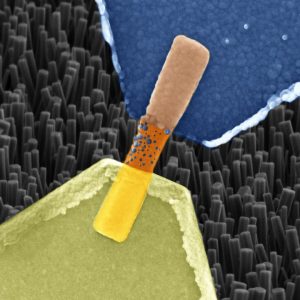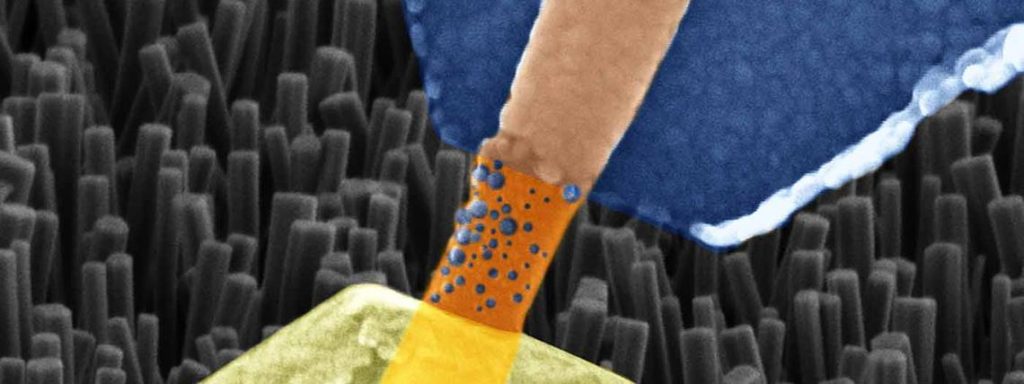A September 27, 2022 news item on phys.org provides an introduction to the later discussion of quantum effects in memristors,
At the nanoscale, the laws of classical physics suddenly become inadequate to explain the behavior of matter. It is precisely at this juncture that quantum theory comes into play, effectively describing the physical phenomena characteristic of the atomic and subatomic world. Thanks to the different behavior of matter on these length and energy scales, it is possible to develop new materials, devices and technologies based on quantum effects, which could yield a real quantum revolution that promises to innovate areas such as cryptography, telecommunications and computation.
The physics of very small objects, already at the basis of many technologies that we use today, is intrinsically linked to the world of nanotechnologies, the branch of applied science dealing with the control of matter at the nanometer scale (a nanometer is one billionth of a meter). This control of matter at the nanoscale is at the basis of the development of new electronic devices.
…
A September 27, 2022 Istituto Nazionale di Ricerca Metrologica (INRIM) press release (summary, PDF, and also on EurekAlert), which originated the news item, provides more information about the research,
Among these, memrisistors are considered promising devices for the realization of new computational architectures emulating functions of our brain, allowing the creation of increasingly efficient computation systems suitable for the development of the entire artificial intelligence sector, as recently shown by INRiM researchers in collaboration with several international universities and research institutes [1,2].
In this context, the EMPIR MEMQuD project, coordinated by INRiM, aims to study the quantum effects in such devices in which the electronic conduction properties can be manipulated allowing the observation of quantized conductivity phenomena at room temperature. In addition to analyzing the fundamentals and recent developments, the review work “Quantum Conductance in Memristive Devices: Fundamentals, Developments, and Applications” recently published in the prestigious international journal Advanced Materials (https://doi.org/10.1002/adma.202201248) analyzes how these effects can be used for a wide range of applications, from metrology to the development of next-generation memories and artificial intelligence.
Here’s a link to and a citation for the paper,
Quantum Conductance in Memristive Devices: Fundamentals, Developments, and Applications by Gianluca Milano, Masakazu Aono, Luca Boarino, Umberto Celano, Tsuyoshi Hasegawa, Michael Kozicki, Sayani Majumdar, Mariela Menghini, Enrique Miranda, Carlo Ricciardi, Stefan Tappertzhofen, Kazuya Terabe, Ilia Valov. Advanced Materials Volume 34, Issue32 August 11, 2022 2201248 DOI: https://doi.org/10.1002/adma.202201248 First published: 11 April 2022
This paper is open access.
You can find the EMPIR (European Metrology Programme for Innovation and Research) MEMQuD (quantum effects in memristive devices) project here, from the homepage,
Memristive devices are electrical resistance switches that couple ionics (i.e. dynamics of ions) with electronics. These devices offer a promising platform to observe quantum effects in air, at room temperature, and without an applied magnetic field. For this reason, they can be traced to fundamental physics constants fixed in the revised International System of Units (SI) for the realization of a quantum-based standard of resistance. However, as an emerging technology, memristive devices lack standardization and insights into the fundamental physics underlying its working principles.
The overall aim of the project is to investigate and exploit quantized conductance effects in memristive devices that operate reliably, in air and at room temperature. In particular, the project will focus on the development of memristive model systems and nanometrological characterization techniques at the nanoscale level of memristive devices, in order to better understand and control the quantized effects in memristive devices. Such an outcome would enable not only the development of neuromorphic systems but also the realization of a standard of resistance implementable on-chip for self-calibrating systems with zero-chain traceability in the spirit of the revised SI.
…
I’m starting to see mention of ‘neuromorphic computing’ in advertisements (specifically a Mercedes Benz car). I will have more about these first mentions of neuromorphic computing in consumer products in a future posting.

